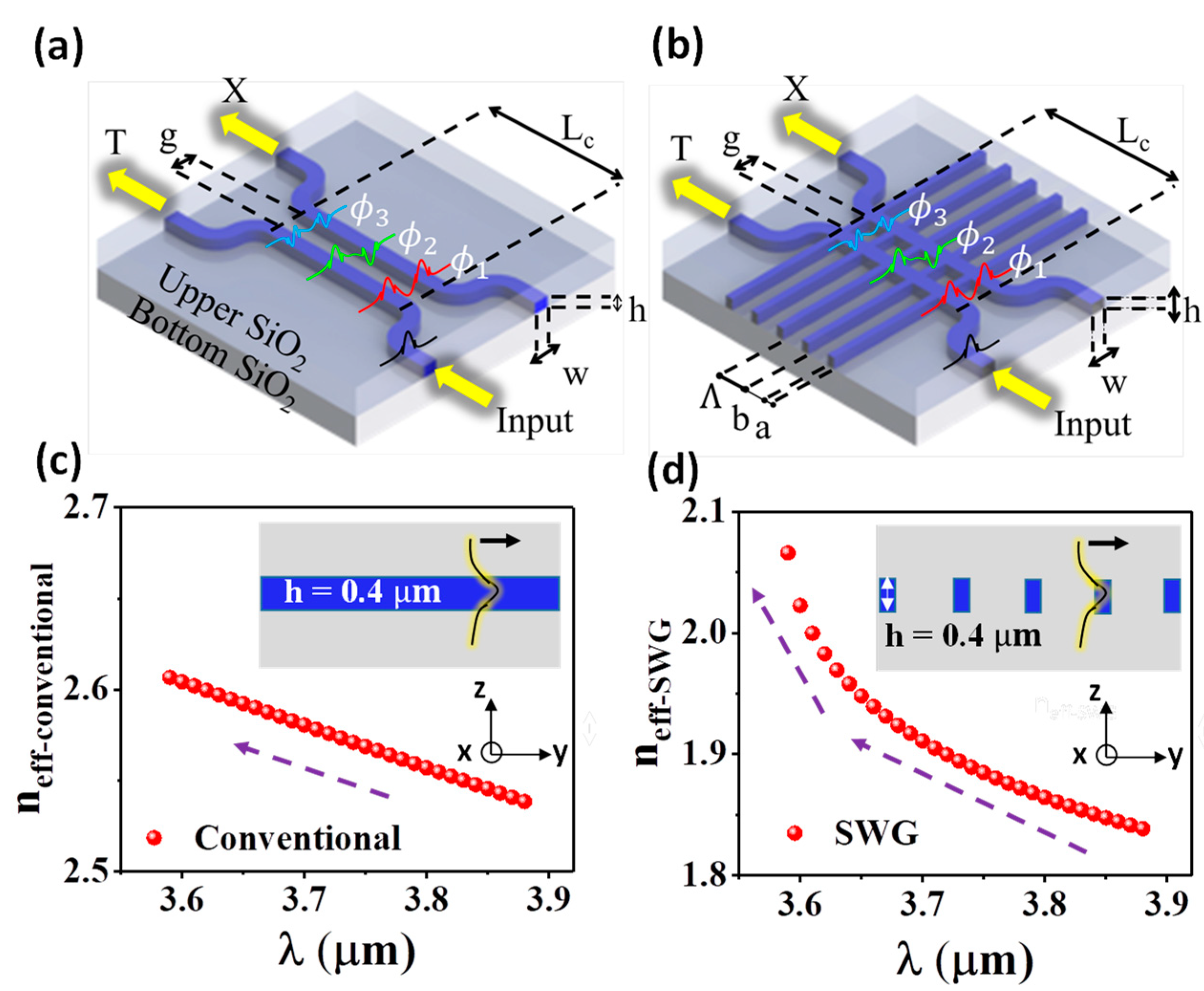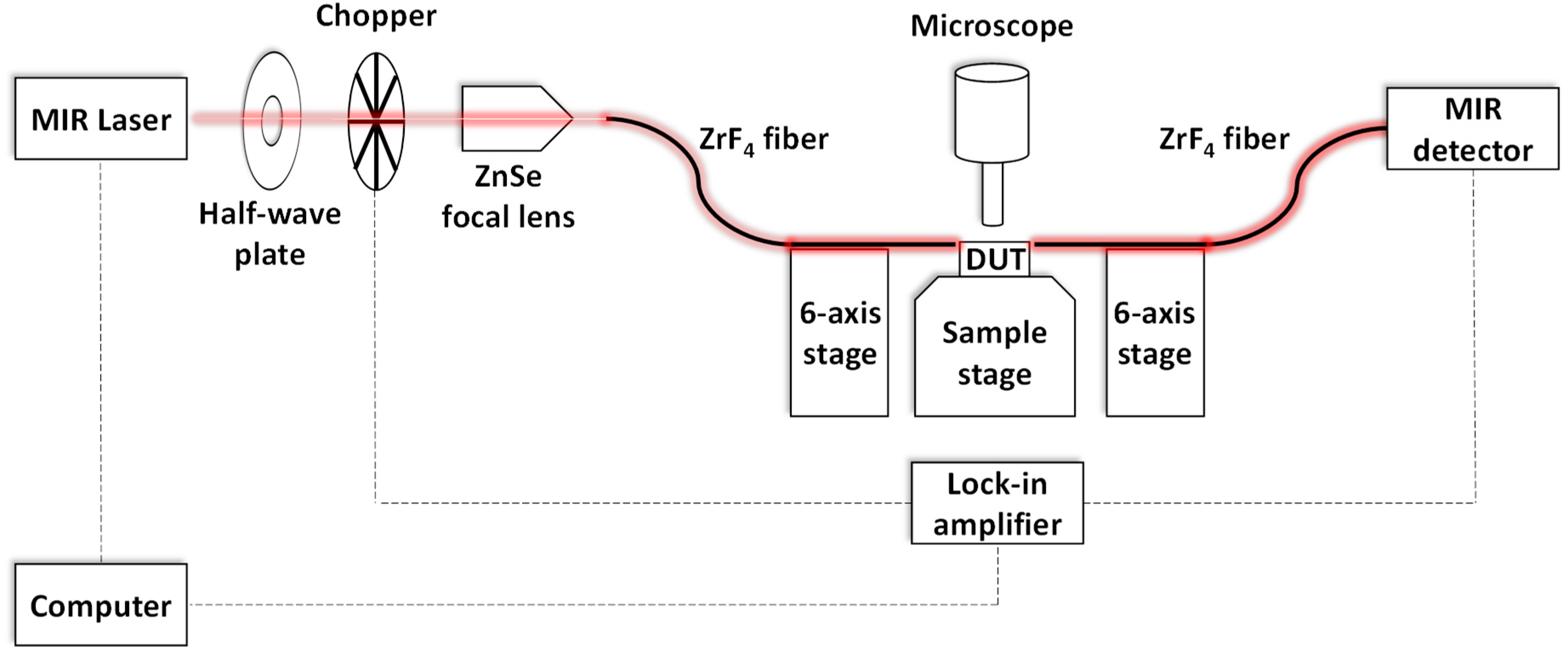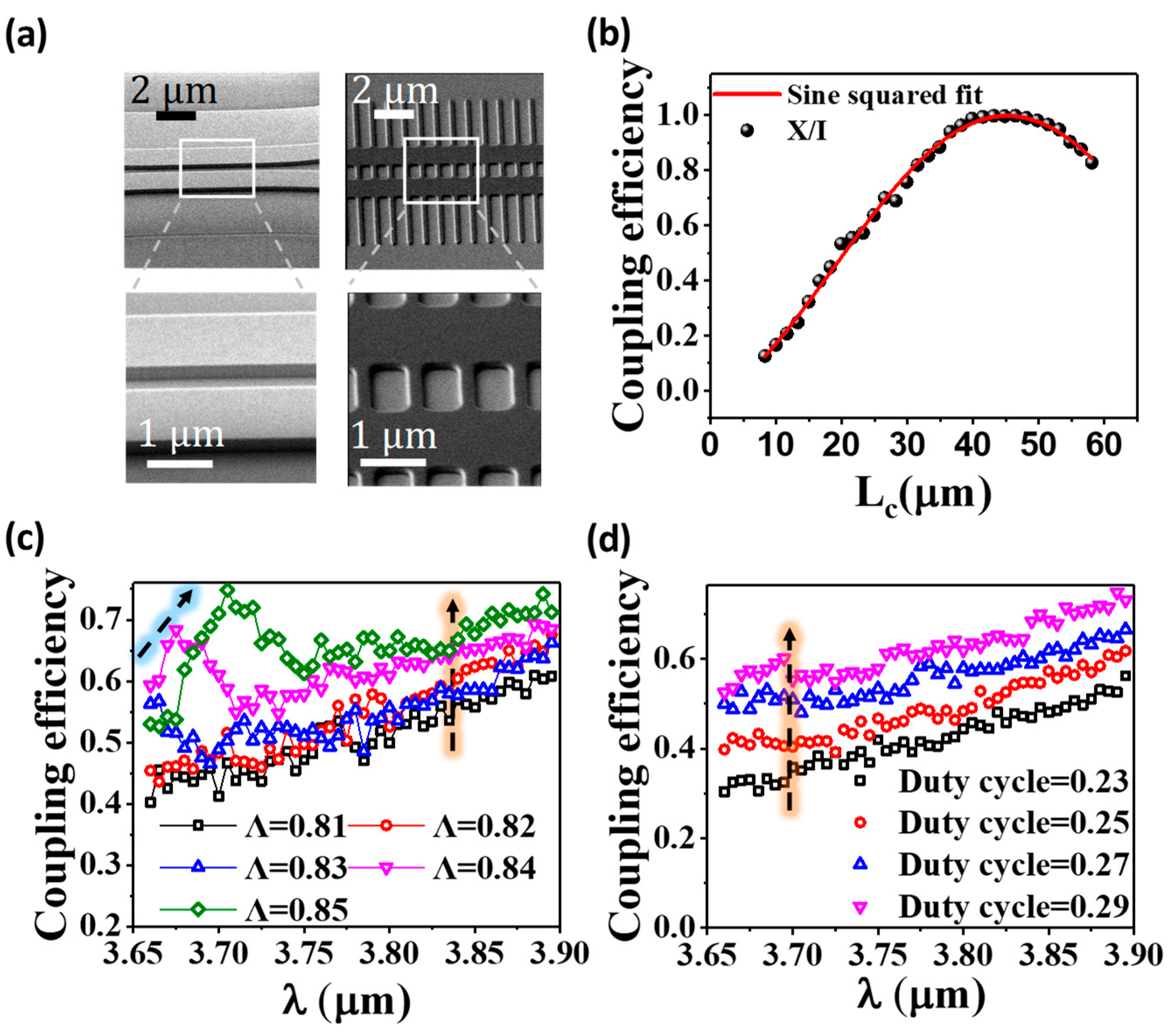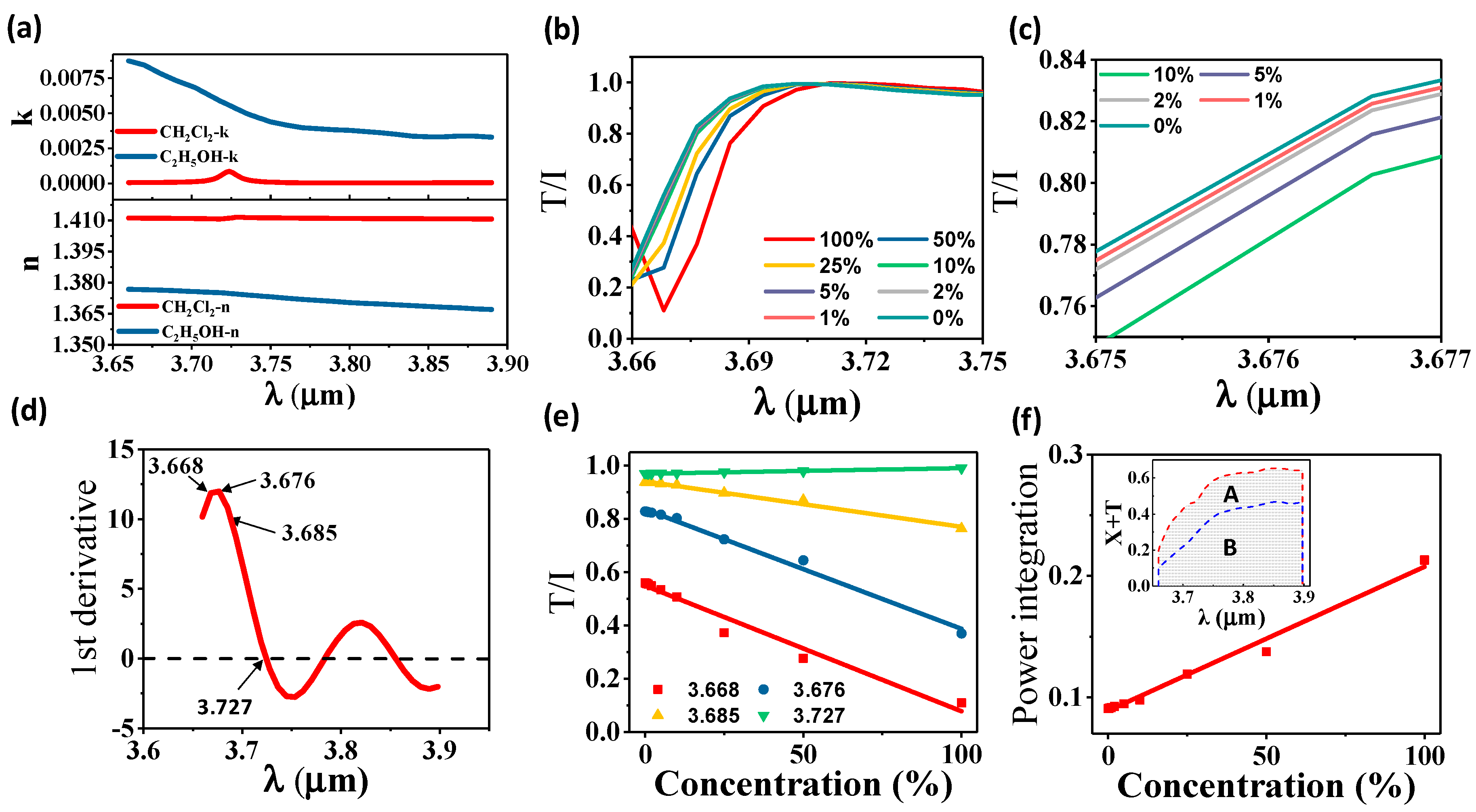Wavelength-Flattened Directional Coupler Based Mid-Infrared Chemical Sensor Using Bragg Wavelength in Subwavelength Grating Structure
Abstract
1. Introduction
2. Concept and Design Optimization
3. Device Fabrication and Characterization
4. Investigation of Sensing Performance
5. Conclusions
Author Contributions
Funding
Conflicts of Interest
References
- Yang, H.; Gijs, M.A.M. Micro-optics for microfluidic analytical applications. Chem. Soc. Rev. 2018, 47, 1391–1458. [Google Scholar] [CrossRef] [PubMed]
- Subramanian, S.; Wu, H.-Y.; Constant, T.; Xavier, J.; Vollmer, F. Label-Free Optical Single-Molecule Micro- and Nanosensors. Adv. Mater. 2018, 1801246. [Google Scholar] [CrossRef] [PubMed]
- Wang, X.; Flueckiger, J.; Schmidt, S.; Grist, S.; Fard, S.T.; Kirk, J.; Doerfler, M.; Cheung, K.C.; Ratner, D.M.; Chrostowski, L. A silicon photonic biosensor using phase-shifted Bragg gratings in slot waveguide. J. Biophotonics 2013, 6, 821–828. [Google Scholar] [CrossRef] [PubMed]
- Zhang, Y.; Zhou, T.; Han, B.; Zhang, A.; Zhao, Y. Optical bio-chemical sensors based on whispering gallery mode resonators. Nanoscale 2018, 10, 13832–13856. [Google Scholar] [CrossRef] [PubMed]
- Dinh, T.V.; Choi, I.Y.; Son, Y.S.; Kim, J.C. A review on non-dispersive infrared gas sensors: Improvement of sensor detection limit and interference correction. Sens. Actuators B Chem. 2016, 231, 529–538. [Google Scholar] [CrossRef]
- Qiao, Q.; Xia, J.; Lee, C.; Zhou, G. Application of photonic crystal nanobeam cavities for sensing. Micromachines 2018, 9, 541. [Google Scholar] [CrossRef]
- Ho, C.P.; Pitchappa, P.; Kropelnicki, P.; Wang, J.; Gu, Y.; Lee, C. Development of Polycrystalline Silicon Based Photonic Crystal Membrane for Mid-Infrared Applications. IEEE J. Sel. Top. Quantum Electron. 2014, 20, 4900107. [Google Scholar] [CrossRef]
- Ho, C.P.; Pitchappa, P.; Kropelnicki, P.; Wang, J.; Cai, H.; Gu, Y.; Lee, C. Characterization of polycrystalline silicon-based photonic crystal-suspended membrane for high temperature applications. J. Nanophotonics 2014, 8, 084096. [Google Scholar] [CrossRef]
- Mai, T.T.; Hsiao, F.L.; Lee, C.; Xiang, W.; Chen, C.C.; Choi, W.K. Optimization and comparison of photonic crystal resonators for silicon microcantilever sensors. Sens. Actuators A Phys. 2011, 165, 16–25. [Google Scholar] [CrossRef]
- Li, B.; Hsiao, F.-L.; Lee, C. Computational Characterization of a Photonic Crystal Cantilever Sensor Using a Hexagonal Dual-Nanoring-Based Channel Drop Filter. IEEE Trans. Nanotechnol. 2011, 10, 789–796. [Google Scholar] [CrossRef]
- Li, B.; Hsiao, F.-L.; Lee, C. Configuration analysis of sensing element for photonic crystal based NEMS cantilever using dual nano-ring resonator. Sens. Actuators A Phys. 2011, 169, 352–361. [Google Scholar] [CrossRef]
- Hsiao, F.-L.; Lee, C. Computational Study of Photonic Crystals Nano-Ring Resonator for Biochemical Sensing. IEEE Sens. J. 2010, 10, 1185–1191. [Google Scholar] [CrossRef]
- Chien, H.T.; Lee, C.; Chiu, H.K.; Hsu, K.C.; Chen, C.C.; Ho, J.A.A.; Chou, C. The comparison between the graded photonic crystal coupler and various couplers. J. Light. Technol. 2009, 27, 2570–2574. [Google Scholar] [CrossRef]
- Wei, J.; Sun, F.; Dong, B.; Ma, Y.; Chang, Y.; Lee, C. Deterministic Aperiodic Photonic Crystal Nanobeam Supporting Adjustable Multiple Mode-matched Resonances. Opt. Lett. 2018, 43, 5407–5410. [Google Scholar] [CrossRef]
- Gordon, R. Biosensing with nanoaperture optical tweezers. Opt. Laser Technol. 2019, 109, 328–335. [Google Scholar] [CrossRef]
- Neubrech, F.; Huck, C.; Weber, K.; Pucci, A.; Giessen, H. Surface-enhanced infrared spectroscopy using resonant nanoantennas. Chem. Rev. 2017, 117, 5110–5145. [Google Scholar] [CrossRef] [PubMed]
- Wang, L.; Li, Y.; Garcia Porcel, M.; Vermeulen, D.; Han, X.; Wang, J.; Jian, X.; Baets, R.; Zhao, M.; Morthier, G. A polymer-based surface grating coupler with an embedded Si3N4layer. J. Appl. Phys. 2012, 111, 114507. [Google Scholar] [CrossRef]
- Rodrigo, D.; Limaj, O.; Janner, D.; Etezadi, D.; García De Abajo, F.J.; Pruneri, V.; Altug, H. Mid-infrared plasmonic biosensing with graphene. Science. 2015, 349, 165–168. [Google Scholar] [CrossRef] [PubMed]
- Rye, J.-M.; Bonnet, C.; Lerouge, F.; Pellarin, M.; Lermé, J.; Parola, S.; Cottancin, E. Single gold bipyramids on a silanized substrate as robust plasmonic sensors for liquid environments. Nanoscale 2018, 10, 16094–16101. [Google Scholar] [CrossRef] [PubMed]
- Hasan, D.; Ho, C.P.; Pitchappa, P.; Yang, B.; Yang, C.; Lee, C. Thermoplasmonic Study of a Triple Band Optical Nanoantenna Strongly Coupled to Mid IR Molecular Mode. Sci. Rep. 2016, 6, 1–15. [Google Scholar] [CrossRef] [PubMed]
- Hasan, D.; Ho, C.P.; Lee, C. Thermally Tunable Absorption-Induced Transparency by a Quasi 3D Bow-Tie Nanostructure for Nonplasmonic and Volumetric Refractive Index Sensing at Mid-IR. Adv. Opt. Mater. 2016, 4, 943–952. [Google Scholar] [CrossRef]
- Koukouvinos, G.; Goustouridis, D.; Misiakos, K.; Kakabakos, S.; Raptis, I.; Petrou, P. Rapid C-reactive protein determination in whole blood with a White Light Reflectance Spectroscopy label-free immunosensor for Point-of-Care applications. Sens. Actuators B Chem. 2018, 260, 282–288. [Google Scholar] [CrossRef]
- Koukouvinos, G.; Petrou, P.S.; Misiakos, K.; Drygiannakis, D.; Raptis, I.; Goustouridis, D.; Kakabakos, S.E. A label-free flow-through immunosensor for determination of total- and free-PSA in human serum samples based on white-light reflectance spectroscopy. Sens. Actuators B Chem. 2015, 209, 1041–1048. [Google Scholar] [CrossRef]
- Leonardi, A.A.; Lo Faro, M.J.; Petralia, S.; Fazio, B.; Musumeci, P.; Conoci, S.; Irrera, A.; Priolo, F. Ultrasensitive Label- and PCR-free Genome Detection based on Cooperative Hybridization of Silicon Nanowires Optical Biosensors. ACS Sens. 2018, 3, 1690–1697. [Google Scholar] [CrossRef] [PubMed]
- Nagatsuka, T.; Uzawa, H.; Tanaka, D.; Oba, Y.; Nishida, Y.; Iwasa, T.; Tayama, K.; Yoshida, T.; Ezaki, T.; Seto, Y. Preparation of silicon nitride biochips for reflectometric interference spectroscopic (RIfS) analysis of biological toxins and E. coli O157:H7 strain. Sens. Actuators B Chem. 2017, 246, 937–942. [Google Scholar] [CrossRef]
- Pagkali, V.; Petrou, P.S.; Salapatas, A.; Makarona, E.; Peters, J.; Haasnoot, W.; Jobst, G.; Economou, A.; Misiakos, K.; Raptis, I.; et al. Detection of ochratoxin A in beer samples with a label-free monolithically integrated optoelectronic biosensor. J. Hazard. Mater. 2017, 323, 75–83. [Google Scholar] [CrossRef] [PubMed]
- Hasan, D.; Lee, C. Hybrid Metamaterial Absorber Platform for Sensing of CO2 Gas at Mid-IR. Adv. Sci. 2018, 5, 1700581. [Google Scholar] [CrossRef] [PubMed]
- Subbaraman, H.; Xu, X.; Hosseini, A.; Zhang, X.; Zhang, Y.; Kwong, D.; Chen, R.T. Recent advances in silicon-based passive and active optical interconnects. Opt. Express 2015, 23, 2487–2511. [Google Scholar] [CrossRef] [PubMed]
- Mashanovich, G.Z.; Gardes, F.Y.; Thomson, D.J.; Hu, Y.; Li, K.; Nedeljkovic, M.; Penades, J.S.; Khokhar, A.Z.; Mitchell, C.J.; Stankovic, S.; et al. Silicon photonic waveguides and devices for near-and mid-IR applications. IEEE J. Sel. Top. Quantum Electron. 2015, 21, 2381469. [Google Scholar] [CrossRef]
- Dong, B.; Guo, X.; Ho, C.P.; Li, B.; Wang, H.; Lee, C.; Luo, X.; Lo, G.Q. Silicon-on-Insulator Waveguide Devices for Broadband Mid-Infrared Photonics Silicon-on-Insulator Waveguide Devices. IEEE Photonics J. 2017, 9, 4501410. [Google Scholar] [CrossRef]
- Spott, A.; Stanton, E.J.; Volet, N.; Peters, D.; Meyer, J.R.; Bowers, J.E. Heterogeneous Integration for Mid-Infrared Silicon Photonics. IEEE J. Sel. Top. Quantum Electron. 2017, 23, 8200810. [Google Scholar] [CrossRef]
- Lavchiev, V.M.; Jakoby, B. Photonics in the Mid-infrared: Challenges in Single-Chip Integration and Absorption sensing. J. Sel. Top. Quantum Electron. 2016, 23, 8200612. [Google Scholar] [CrossRef]
- Mizaikoff, B. Waveguide-enhanced mid-infrared chem/bio sensors. Chem. Soc. Rev. 2013, 42, 8683–8699. [Google Scholar] [CrossRef] [PubMed]
- Tang, S.J.; Liu, S.; Yu, X.C.; Song, Q.; Gong, Q.; Xiao, Y.F. On-Chip Spiral Waveguides for Ultrasensitive and Rapid Detection of Nanoscale Objects. Adv. Mater. 2018, 30, 1800262. [Google Scholar] [CrossRef] [PubMed]
- Tombez, L.; Zhang, E.J.; Orcutt, J.S.; Kamlapurkar, S.; Green, W.M.J. Methane absorption spectroscopy on a silicon photonic chip. Optica 2017, 4, 1322–1325. [Google Scholar] [CrossRef]
- Li, W.; Anantha, P.; Lee, K.H.; Qiu, H.D.; Guo, X.; Zhang, L.; Wang, H.; Tan, C.S. Spiral Waveguides on Germanium-on-Silicon Nitride Platform for Mid-IR Sensing Applications. IEEE Photonics J. 2017, 10, 2201107. [Google Scholar] [CrossRef]
- Gaur, G.; Hu, S.; Mernaugh, R.L.; Kravchenko, I.I.; Retterer, S.T.; Weiss, S.M. Label-free detection of Herceptin® using suspended silicon microring resonators. Sens. Actuators B Chem. 2018, 275, 394–401. [Google Scholar] [CrossRef]
- Huang, S.H.; Sheth, S.; Jain, E.; Jiang, X.; Zustiak, S.P.; Yang, L. Whispering gallery mode resonator sensor for in situ measurements of hydrogel gelation. Opt. Express 2018, 26, 51–62. [Google Scholar] [CrossRef] [PubMed]
- Kumari, B.; Varshney, R.K.; Pal, B.P. Design of chip scale silicon rib slot waveguide for sub-ppm detection of N2O gas at mid-IR band. Sens. Actuators B Chem. 2018, 255, 3409–3416. [Google Scholar] [CrossRef]
- Barrios, C.A.; Gylfason, K.B.; Sánchez, B.; Griol, A.; Sohlström, H.; Holgado, M.; Casquel, R. Slot-waveguide biochemical sensor. Opt. Lett. 2007, 32, 3080–3082. [Google Scholar] [CrossRef] [PubMed]
- Robinson, J.T.; Chen, L.; Lipson, M. On-chip gas detection in silicon optical microcavities. Opt. Express 2008, 16, 4296–4301. [Google Scholar] [CrossRef] [PubMed]
- Chen, C.; Mohr, D.A.; Choi, H.-K.; Yoo, D.; Li, M.; Oh, S.-H. Waveguide-Integrated Compact Plasmonic Resonators for On-Chip Mid-Infrared Laser Spectroscopy. Nano Lett. 2018. [Google Scholar] [CrossRef] [PubMed]
- Schwarz, B.; Reininger, P.; Ristanic, D.; Detz, H.; Andrews, A.M.; Schrenk, W.; Strasser, G. Monolithically integrated mid-infrared lab-on-a-chip using plasmonics and quantum cascade structures. Nat. Commun. 2014, 5, 4085. [Google Scholar] [CrossRef] [PubMed]
- Wang, P.; Hatta, A.M.; Zhao, H.; Zheng, J.; Farrell, G.; Brambilla, G. A ratiometric wavelength measurement based on a silicon-on-insulator directional coupler integrated device. Sensors 2015, 15, 21280–21293. [Google Scholar] [CrossRef] [PubMed]
- Uchiyamada, K.; Okubo, K.; Yokokawa, M.; Carlen, E.T.; Asakawa, K.; Suzuki, H. Micron scale directional coupler as a transducer for biochemical sensing. Opt. Express 2015, 23, 17156–17168. [Google Scholar] [CrossRef] [PubMed]
- Zou, Y.; Chakravarty, S.; Chung, C.-J.; Xu, X.; Chen, R.T. Mid-infrared silicon photonic waveguides and devices [Invited]. Photonics Res. 2018, 6, 254. [Google Scholar] [CrossRef]
- Lin, H.; Luo, Z.; Gu, T.; Kimerling, L.C.; Wada, K.; Agarwal, A.; Hu, J. Mid-infrared integrated photonics on silicon: A perspective. Nanophotonics 2017, 7, 393–420. [Google Scholar] [CrossRef]
- Hu, T.; Dong, B.; Luo, X.; Low, T.-Y.; Song, J.; Lee, C.; Lo, G. Silicon photonic platforms for mid-infrared applications [Invited]. Photonics Res. 2017, 5, 417–430. [Google Scholar] [CrossRef]
- Chen, N.; Dong, B.; Luo, X.; Wang, H.; Singh, N.; Lo, G.-Q.; Lee, C. Efficient and broadband subwavelength grating coupler for 37 μm mid-infrared silicon photonics integration. Opt. Express 2018, 26, 26242. [Google Scholar] [CrossRef]
- Ma, Y.; Dong, B.; Li, B.; Wei, J.; Chang, Y.; Ho, C.P.; Lee, C. Mid-Infrared Slow Light Engineering and Tuning in 1-D Grating Waveguide. IEEE J. Sel. Top. Quantum Electron. 2018, 24, 6101608. [Google Scholar] [CrossRef]
- Chang, Y.; Hasan, D.; Dong, B.; Wei, J.; Ma, Y.; Zhou, G.; Ang, K.W.; Lee, C. All-dielectric surface-enhanced infrared absorption-based gas sensor using guided resonance. ACS Appl. Mater. Interfaces 2018. [Google Scholar] [CrossRef] [PubMed]
- Lin, P.T.; Lin, H.G.; Han, Z.; Jin, T.; Millender, R.; Kimerling, L.C.; Agarwal, A. Label-Free Glucose Sensing Using Chip-Scale Mid-Infrared Integrated Photonics. Adv. Opt. Mater. 2016, 4, 1755–1759. [Google Scholar] [CrossRef]
- Chen, Y.; Lin, H.; Hu, J.; Li, M. Heterogeneously Integrated Silicon Photonics for the Mid-Infrared and Spectroscopic Sensing. ACS Nano 2014, 8, 6955–6961. [Google Scholar] [CrossRef] [PubMed]
- Cheben, P.; Halir, R.; Schmid, J.H.; Atwater, H.A.; Smith, D.R. Subwavelength integrated photonics. Nature 2018, 560, 565–572. [Google Scholar] [CrossRef] [PubMed]
- Ruan, Z.; Shen, L.; Zheng, S.; Wang, A.; Long, Y.; Zhou, N.; Wang, J. Subwavelength grating slot (SWGS) waveguide at 2 μm for chip-scale data transmission. Nanophotonics 2018, 7, 865–871. [Google Scholar] [CrossRef]
- Liu, L.; Deng, Q.; Zhou, Z. Manipulation of beat length and wavelength dependence of a polarization beam splitter using a subwavelength grating. Opt. Lett. 2016, 41, 5126–5129. [Google Scholar] [CrossRef] [PubMed]
- Donzella, V.; Sherwali, A.; Flueckiger, J.; Talebi Fard, S.; Grist, S.M.; Chrostowski, L. Sub-wavelength grating components for integrated optics applications on SOI chips. Opt. Express 2014, 22, 21037–21050. [Google Scholar] [CrossRef] [PubMed]
- Wangüemert-Pérez, J.G.; Hadij-ElHouati, A.; Sánchez-Postigo, A.; Leuermann, J.; Xu, D.X.; Cheben, P.; Ortega-Moñux, A.; Halir, R.; Molina-Fernández, Í. Subwavelength structures for silicon photonics biosensing. Opt. Laser Technol. 2019, 109, 437–448. [Google Scholar] [CrossRef]
- Zhang, Z.; Ng, G.I.; Hu, T.; Qiu, H.; Guo, X.; Wang, W.; Rouifed, M.S.; Liu, C.; Sia, J.; Zhou, J.; et al. Mid-infrared sensor based on a suspended microracetrack resonator with lateral subwavelength-grating metamaterial cladding. IEEE Photonics J. 2018, 10, 6801608. [Google Scholar] [CrossRef]
- Syms, R.R.A.; Cozens, J.R. Optical Guided Waves and Devices, 1st ed.; McGraw-Hill: Berkshire, UK, 1992; ISBN 0077074254. [Google Scholar]
- Halir, R.; Maese-Novo, A.; Ortega-Moñux, A.; Molina-Fernández, I.; Wangüemert-Pérez, J.G.; Cheben, P.; Xu, D.-X.; Schmid, J.H.; Janz, S. Colorless directional coupler with dispersion engineered sub-wavelength structure. Opt. Express 2012, 20, 13470–13477. [Google Scholar] [CrossRef] [PubMed]
- Yariv, A.; Yeh, P. Electromagnetic propagation in periodic stratified media. II. Birefringence, phase matching, and X-ray lasers. J. Opt. Soc. Am. 1976, 67, 438–448. [Google Scholar] [CrossRef]
- Lumerical Solutions, Inc. Innovative Photonic Design Tools. Available online: https://www.lumerical.com (accessed on 28 December 2017).
- Dong, B.; Luo, X.; Hu, T.; Guo, T.X.; Wang, H.; Kwong, D.; Lo, P.G.; Lee, C. Compact Low Loss Mid-Infrared for Arbitrary Power Splitting Ratio Enabled by Rib Waveguide Dispersion Engineering. J. Sel. Top. Quantum Electron. 2018, 24, 4500108. [Google Scholar] [CrossRef]
- Sani, E.; Dell’Oro, A. Spectral optical constants of ethanol and isopropanol from ultraviolet to far infrared. Opt. Mater. 2016, 60, 137–141. [Google Scholar] [CrossRef]
- Reis, J.C.R.; Lampreia, I.M.S.; Santos, Â.F.S.; Moita, M.L.C.J.; Douhéret, G. Refractive Index of Liquid Mixtures: Theory and Experiment. ChemPhysChem 2010, 11, 3722–3733. [Google Scholar] [CrossRef] [PubMed]






© 2018 by the authors. Licensee MDPI, Basel, Switzerland. This article is an open access article distributed under the terms and conditions of the Creative Commons Attribution (CC BY) license (http://creativecommons.org/licenses/by/4.0/).
Share and Cite
Dong, B.; Hu, T.; Luo, X.; Chang, Y.; Guo, X.; Wang, H.; Kwong, D.-L.; Lo, G.-Q.; Lee, C. Wavelength-Flattened Directional Coupler Based Mid-Infrared Chemical Sensor Using Bragg Wavelength in Subwavelength Grating Structure. Nanomaterials 2018, 8, 893. https://doi.org/10.3390/nano8110893
Dong B, Hu T, Luo X, Chang Y, Guo X, Wang H, Kwong D-L, Lo G-Q, Lee C. Wavelength-Flattened Directional Coupler Based Mid-Infrared Chemical Sensor Using Bragg Wavelength in Subwavelength Grating Structure. Nanomaterials. 2018; 8(11):893. https://doi.org/10.3390/nano8110893
Chicago/Turabian StyleDong, Bowei, Ting Hu, Xianshu Luo, Yuhua Chang, Xin Guo, Hong Wang, Dim-Lee Kwong, Guo-Qiang Lo, and Chengkuo Lee. 2018. "Wavelength-Flattened Directional Coupler Based Mid-Infrared Chemical Sensor Using Bragg Wavelength in Subwavelength Grating Structure" Nanomaterials 8, no. 11: 893. https://doi.org/10.3390/nano8110893
APA StyleDong, B., Hu, T., Luo, X., Chang, Y., Guo, X., Wang, H., Kwong, D.-L., Lo, G.-Q., & Lee, C. (2018). Wavelength-Flattened Directional Coupler Based Mid-Infrared Chemical Sensor Using Bragg Wavelength in Subwavelength Grating Structure. Nanomaterials, 8(11), 893. https://doi.org/10.3390/nano8110893





